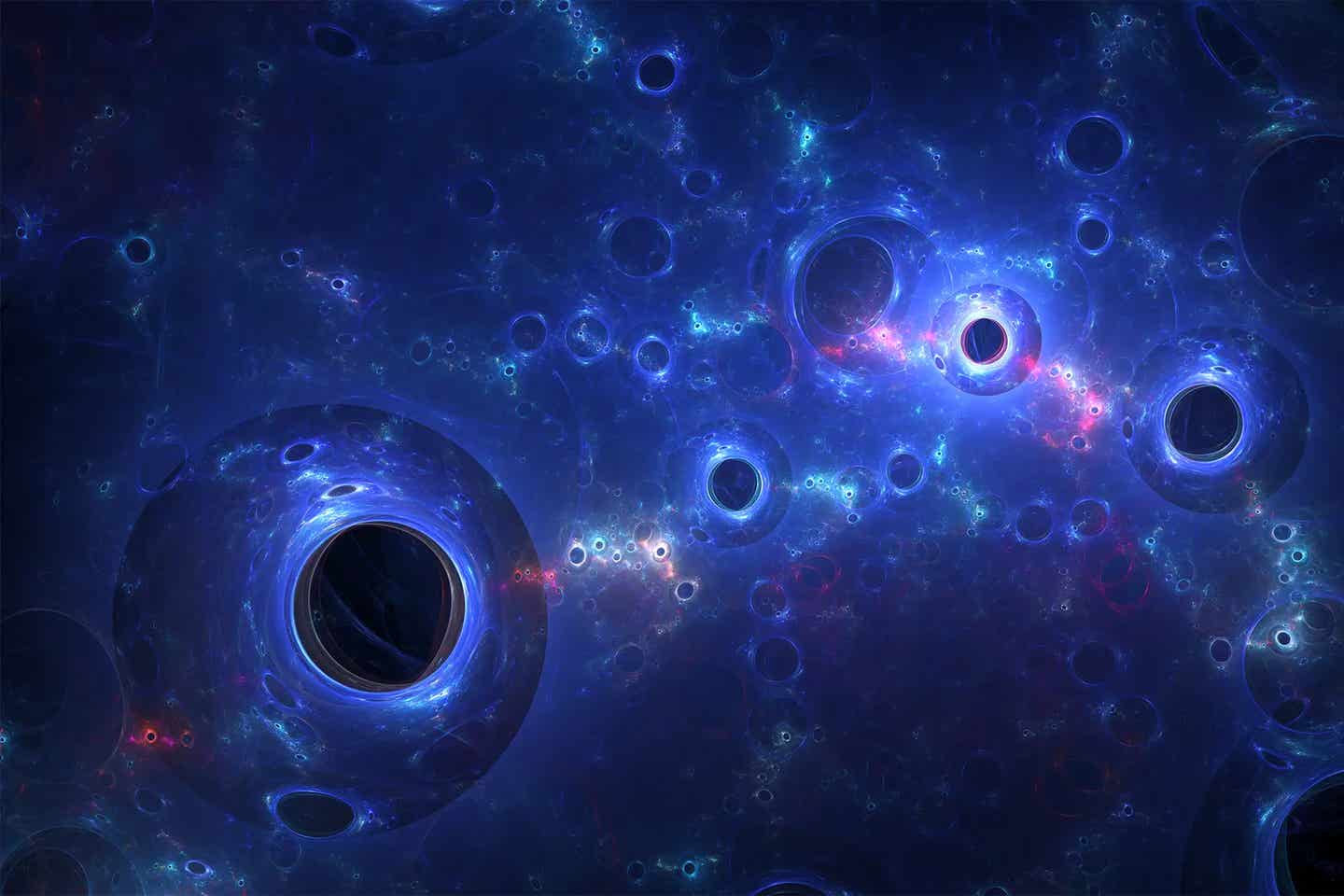‘Dark stars’ existance may have just been validated by the James Webb Telescope
Dark stars are hypothetical types of star that may have existed early in the universe before conventional stars were able to form and thrive

[July 17, 2023: Staff Writer, The Brighter Side of News]
Artist impression of dark stars from the early universe. (CREDIT: iStock Photo)
Stars—those incandescent spheres of hot plasma that grace our night sky—owe their luminosity to the process of fusion, where atoms meld together, releasing energy. However, an international team of astrophysicists suggests there may be an entirely different pathway to stellar power: dark matter.
For millennia, human beings have marvelled at the shimmering spectacle of stars scattered across the cosmic canvas, their brilliance fueled by the process of nuclear fusion. Yet, a groundbreaking theory proposed by a group of three astrophysicists suggests that there may exist another, previously unknown source of stellar power.
Enter the concept of "dark stars," objects far grander and more radiant than our own Sun, with their luminosity driven not by the fusion of atoms, but by the annihilation of enigmatic dark matter particles.
Dark stars are a hypothetical type of star that may have existed early in the universe before conventional stars were able to form and thrive. The stars would be composed mostly of normal matter, like modern stars, but a high concentration of neutralino dark matter present within them would generate heat via annihilation reactions between the dark-matter particles. This heat would prevent such stars from collapsing into the relatively compact and dense sizes of modern stars and therefore prevent nuclear fusion among the 'normal' matter atoms from being initiated.
Related Stories
Under this model, a dark star is predicted to be an enormous cloud of molecular hydrogen and helium ranging between 4 and 2,000 astronomical units in diameter and with a surface temperature and luminosity low enough that the emitted radiation would be invisible to the naked eye.
Dr. Katherine Freese from The University of Texas at Austin, and her collaborators, Dr. Cosmin Ilie and Jillian Paulin '23 from Colgate University, have made headlines in the astrophysics community by identifying three bright objects, potentially dark stars, through the powerful lens of the James Webb Space Telescope (JWST). The discovery, if validated, could offer an unprecedented window into understanding the nature of dark matter—an unsolved enigma at the heart of contemporary physics.
Freese, the director of the Weinberg Institute for Theoretical Physics and the Jeff and Gail Kodosky Endowed Chair in Physics at UT Austin, expressed her excitement over the discovery. “Discovering a new type of star is pretty interesting all by itself, but discovering it’s dark matter that’s powering this—that would be huge,” she said.
Dark matter, despite constituting about a quarter of the universe, has always evaded scientific understanding. It is hypothesized to consist of a new type of elementary particle, a supposition that has instigated a fervent search amongst scientists globally.
These three objects (JADES-GS-z13-0, JADES-GS-z12-0, and JADES-GS-z11-0) were originally identified as galaxies in December 2022 by the JWST Advanced Deep Extragalactic Survey (JADES). Now, a team including Katherine Freese at The University of Texas at Austin speculate they might actually be “dark stars,” theoretical objects much bigger and brighter than our sun, powered by particles of dark matter annihilating. (CREDIT: NASA/ESA)
High on the list of possible dark matter constituents are Weakly Interacting Massive Particles (WIMPs), which upon collision, annihilate themselves, transmuting into heat. This heat, in turn, would convert collapsing hydrogen clouds into brilliantly shining dark stars. Identifying supermassive dark stars and studying their properties could potentially bring us a step closer to understanding the nature of dark matter.
The groundbreaking research by Freese, Ilie, and Paulin has been published in the esteemed Proceedings of the National Academy of Sciences.
Future observations from the JWST, which would delve into the objects' spectroscopic properties—including any anomalies in light intensity within certain frequency bands—could help confirm whether these candidate objects are indeed dark stars.
Images of six candidate massive galaxies, seen 500-800 million years after the Big Bang. (CREDIT: NASA/ESA/CSA/I. Labbe)
The potential existence of dark stars might also help resolve a conundrum posed by the JWST. There seem to be an excessive number of large galaxies in the early universe, a finding that doesn't align with the predictions of the standard model of cosmology. "It's more likely that something within the standard model needs tuning, because proposing something entirely new, as we did, is always less probable," Freese elaborated. "But if some of these objects that look like early galaxies are actually dark stars, the simulations of galaxy formation agree better with observations."
The trio of potential dark stars—dubbed JADES-GS-z13-0, JADES-GS-z12-0, and JADES-GS-z11-0—were initially classified as galaxies in December 2022 by the JWST Advanced Deep Extragalactic Survey (JADES). Through meticulous spectroscopic analysis, the JADES team confirmed that these objects were observed approximately 320 to 400 million years post-Big Bang, making them among the earliest known objects in the universe.
Freese presented two possible interpretations of the JWST data. "One is that they are galaxies containing millions of ordinary, population-III stars. The other is that they are dark stars. And believe it or not, one dark star has enough light to compete with an entire galaxy of stars," she noted.
In theory, dark stars could grow several million times the mass of our sun and shine up to 10 billion times brighter. "We predicted back in 2012 that supermassive dark stars could be observed with JWST," said Ilie, assistant professor of physics and astronomy at Colgate University. "As shown in our recently published PNAS article, we already found three supermassive dark star candidates when analyzing the JWST data for the four high redshift JADES objects spectroscopically confirmed by Curtis-Lake et al, and I am confident we will soon identify many more."
The concept of dark stars was born out of a series of discussions between Freese and Doug Spolyar, then a graduate student at the University of California, Santa Cruz. They pondered over the role of dark matter in the genesis of the universe's earliest stars. Subsequently, Paolo Gondolo, an astrophysicist at the University of Utah, joined the collaboration. After several years of research and development, they unveiled their pioneering dark stars theory in the journal Physical Review Letters in 2008.
In this theoretical model, the core of early protogalaxies hosted dense clumps of dark matter, alongside clouds of hydrogen and helium gas. As the gas cooled, it collapsed, pulling in dark matter. With increasing density, the dark matter particles began to annihilate, continuously adding heat and preventing the gas from collapsing entirely.
Instead of forming a dense core to support fusion—as would happen in an ordinary star—the collapsing gas would continue to accumulate more matter, growing bigger, puffier, and much brighter. Unlike standard stars, whose energy source is confined to the core, the power source of dark stars would be spread evenly. Provided there's enough dark matter, dark stars could grow to be several million times the mass of our sun and up to 10 billion times as bright.
The dark star theory, if confirmed, not only reshapes our understanding of star formation but also promises to unlock the mysteries of dark matter—a monumental leap in the realm of astrophysics. The universe, it seems, still holds many secrets, waiting to be unveiled by the ever-watchful eyes of science.
Note: Materials provided above by The Brighter Side of News. Content may be edited for style and length.
Like these kind of feel good stories? Get the Brighter Side of News' newsletter.
Joseph Shavit
Head Science News Writer | Communicating Innovation & Discovery
Based in Los Angeles, Joseph Shavit is an accomplished science journalist, head science news writer and co-founder at The Brighter Side of News, where he translates cutting-edge discoveries into compelling stories for a broad audience. With a strong background spanning science, business, product management, media leadership, and entrepreneurship, Joseph brings a unique perspective to science communication. His expertise allows him to uncover the intersection of technological advancements and market potential, shedding light on how groundbreaking research evolves into transformative products and industries.



